Optimizing County-Level Land-Use Structure Method: Case Study of W County, China
Abstract
1. Introduction
2. Theoretical Cognition
2.1. Integratiing Developmental and Spatial Planning for Land-Use Structure Optimization
2.2. Integrating Ecological Progress in Land-Use Structure Optimization
2.3. Method Summarization
3. Research Methods
3.1. Basic Preparations
3.1.1. Constructing a Target System
3.1.2. Creating Uniform Planning Timeframes and Spatial Data
3.1.3. Defining Land Classification Standard
3.2. Method Flow
3.2.1. Determining the Area of Ecological Redline
3.2.2. Determining the Demand for Land to Realize Socio-Economic Development
- Calculating the Demand for Land to Realize GDP
- 2.
- Calculating the Demand for Land to Realize Population Development
- 3.
- Calculating the Demand for Land to Realize Socio-Economic Development
3.2.3. Determining the Carrying Capacity of Land
3.2.4. Determining the Optimal Land-Use Structure
4. Results
4.1. Data Source and Data Processing
4.2. Ecological Redline Area in W County
4.3. Area Demand to Realize Socio-Economic Development in W County
4.3.1. Area Demand to Realize GDP
- Proportion of Each Product Contributing to Primary Industry Output Value
- 2.
- Area Demand of Land-Use Types
4.3.2. Area Demand to Realize Population Development
4.3.3. Area Demand to Realize Socio-Economic Development
4.4. Carrying Capacity of Land in W County
4.5. Optimal Land-Use Structure in W County
4.5.1. Equivalence, Regulation, and Comprehensive Factors
4.5.2. Ecological Footprint Generated by Socio-Economic Development
4.5.3. Ecological Carrying Capacity and Its State
4.5.4. Optimal Land-Use Structure in W County
5. Discussion
6. Conclusions
Author Contributions
Funding
Institutional Review Board Statement
Informed Consent Statement
Data Availability Statement
Acknowledgments
Conflicts of Interest
References
- Fetscher, I. Conditions for the Survival of Humanity: On the Dialectics of Progress. Universitas 1978, 20, 161–172. [Google Scholar]
- Marcin, D.; Katarzyna, P. The Development of Strategic Spatial Planning in Central and Eastern Europe: Between Path Dependence, European Influence, and Domestic Politics. Plan. Perspect. 2018, 33, 571–589. [Google Scholar]
- European Commission. European Spatial Development Perspective (ESDP)—Towards Balanced and Sustainable Development of the Territory of the EU; European Commission: Luxembourg, 1999; pp. 5–82. [Google Scholar]
- Faludi, A. A Turning Point in the Development of European Spatial Planning? The ‘Territorial Agenda of the European Union’ and the ‘First Action Programme’. Prog. Plan. 2009, 71, 1–42. [Google Scholar] [CrossRef]
- Marshall, T. The European Union and Major Infrastructure Policies: The Reforms of the Trans-European Networks Programmes and the Implications for Spatial Planning. Eur. Plan. Stud. 2014, 22, 1484–1506. [Google Scholar] [CrossRef][Green Version]
- Judith, W.; Arnoud, L.; Stefanie, D.; Pat, V.D.J.; Annet, K. Contested Spaces? The Use of Place Concepts to Communicate Visions for Peri-Urban Areas. Eur. Plan. Stud. 2013, 21, 780–800. [Google Scholar]
- Mommaas, H.; Janssen, J. Towards A Synergy Between ‘Content’ and ‘Process’ in Dutch Spatial Planning: The Heuvelland Case. J. Hous. Built. Environ. 2008, 23, 21–35. [Google Scholar] [CrossRef][Green Version]
- Valk, A.V.D. The Dutch Planning Experience. Landsc. Urban Plan. 2002, 58, 201–210. [Google Scholar] [CrossRef]
- Schrijnen, P.M. Infrastructure Networks and Red-green Patterns in City Regions. Landsc. Urban Plan. 2000, 48, 191–204. [Google Scholar] [CrossRef]
- Lambooy, J.G. Polynucleation and Economic Development:The Randstad. Eur. Plan. Stud. 1998, 6, 457–467. [Google Scholar] [CrossRef]
- Priemus, H. Planning the Randstad: Between Economic Growth and Sustainability. Urban Stud. 1994, 31, 509–534. [Google Scholar] [CrossRef]
- Han, A.T.; Go, M.H. Explaining the National Variation of Land-use: A Cross-National Analysis of Greenbelt Policy in Five Countries. Land Use Policy 2019, 81, 644–656. [Google Scholar] [CrossRef]
- Gant, R.L.; Robinson, G.M.; Fazal, S. Land-use Change in the ‘Edgelands’: Policies and Pressures in London’s Rural–Urban Fringe. Land Use Policy 2011, 28, 266–279. [Google Scholar] [CrossRef]
- Kim, H.; Jung, Y.; Oh, J.I. Transformation of Urban Heat Island in the Three-Center City of Seoul, South Korea: The Role of Master Plans. Land Use Policy 2019, 86, 328–338. [Google Scholar] [CrossRef]
- Shaw, D.; Lord, A. From Land-use to ‘Spatial Planning’: Reflections on the Reform of the English Planning System. Town Plan. Rev. 2009, 80, 415–435. [Google Scholar] [CrossRef]
- Mark, B.; Jon, C.; Graeme, S. Achieving Successful Participation in the New UK Spatial Planning System. Plan. Pract. Res. 2007, 22, 79–93. [Google Scholar]
- Colomb, C.; Tomaney, J. Territorial Politics, Devolution and Spatial Planning in the UK: Results, Prospects, Lessons. Plan. Pract. Res. 2016, 31, 1–22. [Google Scholar] [CrossRef]
- Marshall, T. After Structure Planning: The New Sub-Regional Planning in England. Eur. Plan. Stud. 2007, 15, 107–132. [Google Scholar] [CrossRef]
- Goncalves, J.; Ferreira, J.A. The Planning of Strategy: A Contribution to the Improvement of Spatial Planning. Land Use Policy 2015, 45, 86–94. [Google Scholar] [CrossRef]
- Issaoui, M.; Sinz, M. Leitbilder und Handlungsstrategien für die Raumentwicklung in Deutschland. Standort 2010, 34, 80–87. [Google Scholar] [CrossRef]
- Stefanie, D. Spatial Policies for Regional Sustainable Development: A Comparison of Graphic and Textual Representations in Regional Plans in England and Germany. Reg. Stud. 2005, 39, 1167–1182. [Google Scholar]
- Wende, W.; Huelsmann, W.; Marty, M.; Penn-Bressel, G.; Bobylev, N. Climate Protection and Compact Urban Structures in Spatial Planning and Local Construction Plans in Germany. Land Use Policy 2010, 27, 864–868. [Google Scholar] [CrossRef]
- The Department of Planning, Monitoring & Evaluation (DPME). Integrated Planning Framework Bill, 2018—Draft. Available online: https://pmg.org.za/call-for-comment/659/ (accessed on 3 May 2018).
- Marshall, T. Infrastructure Futures and Spatial Planning: Lessons from France, the Netherlands, Spain and the UK. Prog. Plann. 2014, 89, 1–38. [Google Scholar] [CrossRef]
- Matthew, M.; Lynn, S.; Daniel, K. Large Landscape Conservation: A Strategic Framework for Policy and Action. Available online: http://www.america2050.org/ (accessed on 10 June 2010).
- Davis, J.M.; Eder, B.K.; Nychka, D.; Yang, Q. Modeling the Effects of Meteorology on Ozone in Houston Using Cluster Analysis and Generalized Additive Models. Atmos. Environ. 1998, 32, 2505–2520. [Google Scholar] [CrossRef]
- Davis, R.E.; Walker, D.R. An Upper-Air Synoptic Climatology of the Western United States. J. Clim. 1992, 5, 1449–1467. [Google Scholar] [CrossRef]
- Japanese Transport Ministry. Comprehensive Information Map. Available online: https://www.town.samukawa.kanagawa.jp/~gis/index.html#5/35.362222/138.731389/&base=std&ls=std&disp=1&vs=c1j0l0u0f0 (accessed on 19 July 2019).
- Asato, S.; Andy, T. Shifts in Tokyo’s World City Status and the Urban Planning Response. Urban Stud. 2003, 40, 665–685. [Google Scholar]
- Van Lier, H.N. The Role of Land-use Planning in Sustainable Rural Systems. Landsc. Urban. Plan. 1998, 41, 83–91. [Google Scholar] [CrossRef]
- Zanon, B.; Verones, S. Climate Change, Urban Energy and Planning Practices: Italian Experiences of Innovation in Land Management Tools. Land Use Policy 2013, 32, 343–355. [Google Scholar] [CrossRef]
- Viegas, C.; Saldanha, D.L.; Bond, A.G.; Ribeiro, J.L.D. Urban Land Planning: The Role of A Master Plan in Influencing Local Temperatures. Cities 2013, 35, 1–13. [Google Scholar] [CrossRef]
- Olofsson, P.; Foody, G.M.; Herold, M.; Stehman, S.V.; Woodcock, C.E.; Wulder, M.A. Good Practices for Estimating Area and Assessing Accuracy of Land Change. Remote Sens. Environ. 2014, 148, 42–57. [Google Scholar] [CrossRef]
- Persson, C. Deliberation or doctrine? Land-use and spatial planning for sustainable development in Sweden. Land Use Policy 2013, 34, 301–313. [Google Scholar] [CrossRef]
- Bruner, A.G.; Gullison, R.E.; Rice, R.E.; da Fonseca, G.A.B. Effectiveness of Parks in Protecting Tropical Biodiversity. Science 2001, 291, 125–128. [Google Scholar] [CrossRef]
- Pouzols, F.M.; Toivonen, T.; Minin, E.D.; Kukkala, A.S.; Kullberg, P.; Kuusterä, J.; Lehtomäki, J.; Tenkanen, H.; Verburg, P.H.; Moilanen, A. Global Protected Area Expansion is Compromised by Projected Land-use and Parochialism. Nature 2014, 516, 383–386. [Google Scholar] [CrossRef]
- Watson, J.E.M.; Dudley, N.; Segan, D.B.; Hockings, M. The Performance and Potential of Protected Areas. Nature 2014, 515, 67–73. [Google Scholar] [CrossRef]
- Phalan, B.; Onial, M.; Balmford, A.; Green, R.E. Reconciling Food Production and Biodiversity Conservation: Land Sharing and Land Sparing Compared. Science 2011, 333, 1289–1291. [Google Scholar] [CrossRef]
- Bocco, G.; Mendoza, M.; Velazquez, A. Remote Sensing and GIS-Based Regional Geomorphological Mapping—A Tool for Land-use Planning in Developing Countries. Geomorphology 2001, 39, 211–219. [Google Scholar] [CrossRef]
- Hessel, R.; van den Berg, J.; Kaboré, O.; van Kekem, A.; Verzandvoort, S.; Dipama, J.-M.; Diallo, B. Linking Participatory and GIS-Based Land-use Planning Methods: A Case Study from Burkina Faso. Land Use Policy 2009, 26, 1162–1172. [Google Scholar] [CrossRef]
- Sharifi, M.A.; Van Keulen, H. A Decision Support System for Land-use Planning at Farm Enterprise Level. Agric. Syst. 1994, 45, 239–257. [Google Scholar] [CrossRef]
- Chuvieco, E. Integration of Linear Programming and GIS for Land-use Modelling. Int. J. Geogr. Inf. Syst. 1997, 45, 71–83. [Google Scholar] [CrossRef]
- Lloyd, M.G.; Peel, D. Shaping and Designing Model Policies for Land-use Planning. Land Use Policy 2007, 24, 154–164. [Google Scholar] [CrossRef]
- Loret, E.; Martino, L.; Fea, M.; Sarti, F. Combined Remote Sensing and GIS Techniques for Studying the Large Roman Urban System Expansion during the Last Twenty Years. Adv. Remote Sens. 2007, 24, 154–164. [Google Scholar] [CrossRef]
- Jean, N.; Burke, M.; Xie, M.; Davis, W.M.; Lobell, D.B.; Ermon, S. Combining Satellite Imagery and Machine Learning to Predict Poverty. Science 2016, 353, 790–794. [Google Scholar] [CrossRef] [PubMed]
- Tudor, C.A.; Iojă, I.C.; Pătru-Stupariu, I.; Niță, M.R.; Hersperger, A.M. How Successful is the Resolution of Land-use Conflicts? A Comparison of Cases from Switzerland and Romania. Appl. Geogr. 2014, 47, 125–136. [Google Scholar] [CrossRef]
- Vasu, D.; Srivastava, R.; Patil, N.G.; Tiwary, P.; Chandran, P.; Kumar Singh, S. A Comparative Assessment of Land Suitability Evaluation Methods for Agricultural Land-use Planning at Vvillage Level. Land Use Policy 2018, 79, 146–163. [Google Scholar] [CrossRef]
- Nguyen, T.T.; Verdoodt, A.; Van, Y.T.; Delbecque, N.; Tran, T.C.; Van Ranst, E. Design of a GIS and Multi-Criteria Based Land Evaluation Procedure for Sustainable Land-use Planning at the Regional Level. Agric. Ecosyst. Environ. 2015, 200, 1–11. [Google Scholar] [CrossRef]
- Elsayed, M.A.; Ismaeel, W.S.E. Environmental Assessment for Major Development Projects: A Case Study “Qattara Depression”. J. Clean. Prod. 2019, 215, 522–533. [Google Scholar] [CrossRef]
- Santoso, E.B.; Erli, H.K.D.M.; Aulia, B.U.; Ghozali, A. Concept of Carrying Capacity: Challenges in Spatial Planning (Case Study of East Java Province, Indonesia). Procedia Soc. Behav. Sci. 2014, 135, 130–135. [Google Scholar] [CrossRef]
- Chen, W.; Sun, W.; Chen, J.L. Decoding the Conflicts within the Planning System and Approaches to Multi-plan Integration at the County and Municipal Level in China. Geogr. Res. 2017, 36, 1603–1612. (In Chinese) [Google Scholar]
- Gu, C.L. On the Separation of China’s Spatial Plans and Their Evolution and Integration. Geogr. Res. 2015, 34, 601–613. (In Chinese) [Google Scholar]
- Wu, J.Y.; Song, Y.; Lin, J.; He, Q.S. Tackling the Uncertainty of Spatial Regulations in China: An Institutional Analysis of the “Multi-plan Combination”. Land Use Policy 2018, 78, 1–12. [Google Scholar] [CrossRef]
- Wang, Y.; Liu, X.L.; Wei, X.H.; Yu, H.W. The Method and Practice of Regional Spatial Planning from “Three Basic Spaces” to “Three-Zones and Three-Lines”. Urban Plan. Forum. 2018, 62, 65–74. (In Chinese) [Google Scholar]
- Zhang, X.F.; Wang, C.S.; Li, M. Demarcating Ecological Space and Ecological Protection Red Line Under the Framework of Territory Spatial Planning. Geogr. Res. 2019, 38, 2430–2446. (In Chinese) [Google Scholar]
- Yang, X.H.; Jin, X.B.; Jia, P.H.; Ren, J.; Wu, D.G.; Cao, S.; Zhou, Y.K. Designation method and demonstration of permanent basic farmland in county level on view of multi-planning integration. Trans. CSAE 2019, 35, 250–259. [Google Scholar]
- Wei, X.H.; Kai, X.; Wang, Y.; Yu, H.W. Discussions on the methods of “Three-Zones and Three-Lines” implementation at the spatial levels of city and county based on “double evaluation”. City Plan. Rev. 2019, 43, 11–20. [Google Scholar]
- Ministry of Ecology and Environment of the People’s Republic of China. Guide to Delimitation of Ecological Redline. Available online: http://www.mee.gov.cn/gkml/hbb/bwj/201505/t20150518_301834.htm (accessed on 8 May 2015).
- The General Office of the Communist Party of China Central Committee and the General Office of the State Council. The Opinions on Establishing a Land Planning System and Supervising Its Implementation. Available online: http://www.gov.cn/zhengce/2019-05/23/content_5394187.htm (accessed on 23 May 2019).
- Daily, G.C.; Ehrlich, P.R. Population, Sustainability, and Earth’s Carrying Capacity. BioScience 1992, 42, 761–771. [Google Scholar] [CrossRef]
- Rees, W.E. Revisiting Carrying Capacity: Area-Based Indicators of Sustainability. Popul. Environ. 1996, 17, 195–215. [Google Scholar] [CrossRef]
- Costanza, R.; d′Arge, R.; Groot, R.D.; Farber, S.; Grasso, M.; Hannon, B.; Limburg, K.; Naeem, S.; O’Neill, R.V.; Paruelo, J.; et al. The Value of the World’s Ecosystem Services and Natural Capital. Ecol. Econ. 1998, 25, 3–15. [Google Scholar] [CrossRef]
- Wackernagel, M.; Rees, W.E. Perceptual and Structural Barriers to Investing in Natural Capital: Economics from An Ecological Foot-print Perspective. Ecol. Econ. 1997, 20, 3–24. [Google Scholar] [CrossRef]
- Wackernagel, M.; Onisto, L.; Bello, P.; Linares, A.C.; Falfan, I.S.L.; Garcνa, J.M.; Guerrero, A.I.S.; Guerrero, M.G.S. National natural capital accounting with the ecological footprint concept. Ecol. Econ. 1999, 29, 375–390. [Google Scholar] [CrossRef]
- Borucke, M.; Moore, D.; Cranston, G.; Gracey, K.; Katsunori, I.; Larsoa, J.; Lazaru, E.; Moralea, J.C.; Wackernagea, M.; Galli, A. Accounting for demand and supply of the biosphere’s regenerative capacity: The National Footprint Accounts’ underlying methodology and framework. Ecol. Indic. 2013, 24, 518–533. [Google Scholar] [CrossRef]
- Cucek, L.; Klemes, J.J.; Kravanja, Z. A review of Footprint analysis tool for monitoring impacts on sustainability. J. Clean. Prod. 2012, 34, 9–20. [Google Scholar] [CrossRef]
- Scotti, M.; Bondavalli, C.; Bodini, A. Ecological Footprint as a tool for local sustainability: The municipality of Piacenza (Italy) as a case study. Environ. Impact Assess. Rev. 2009, 29, 39–50. [Google Scholar] [CrossRef]
- Shen, C.; Xu, J.Q. Vision System and Connection Design for Multiple Plans Integration: A Innovation of Three Visions. Planner 2015, 31, 12–16. (In Chinese) [Google Scholar]
- Ministry of Natural Resources of the People′s Republic of China. Land-Use Present Situation Classification (GB/T 21010-2017). Available online: http://www.mnr.gov.cn/dt/ywbb/201810/t20181030_2288891.html (accessed on 3 November 2017).
- Ministry of Natural Resources of the People′s Republic of China. Guide to Land-Use Classification in Spatial Planning. Available online: http://gi.mnr.gov.cn/202011/t20201120_2589186.html (accessed on 17 November 2020).
- Ministry of Natural Resources of the People’s Republic of China. Guidelines for the Zoning and Use Classification of Land Space Planning in Cities and Counties. Available online: https://mp.weixin.qq.com/s?src=11×tamp=1635305219&ver=3399&signature=o1TswBQGVvqyqShPK17ojlcIPpMgR57*sj9gvVm92vPN2HNeG5mILBhJK9R2TPYyYjgdiOgTva0YfghJfnfKZFP0Du8kzUG8J5bMCyVRBYBgBHOfN0ZvWDttmPbfWdeA&new=1 (accessed on 26 May 2020).
- Xie, G.D.; Zhen, L.; Lu, C.X.; Xiao, Y.; Chen, C. Expert Knowledge Based Valuation Method of Ecosystem Services in China. J. Nat. Resour. 2008, 23, 911–919. (In Chinese) [Google Scholar]
- Xie, H.Y.; Chen, X.S.; Yang, M.Z.; Zhao, H.Q.; Zhao, M.C. The Ecological Footprint Analysis of 1kg Livestock Product of China. Acta Ecol. Sin. 2009, 29, 3264–3270. [Google Scholar]
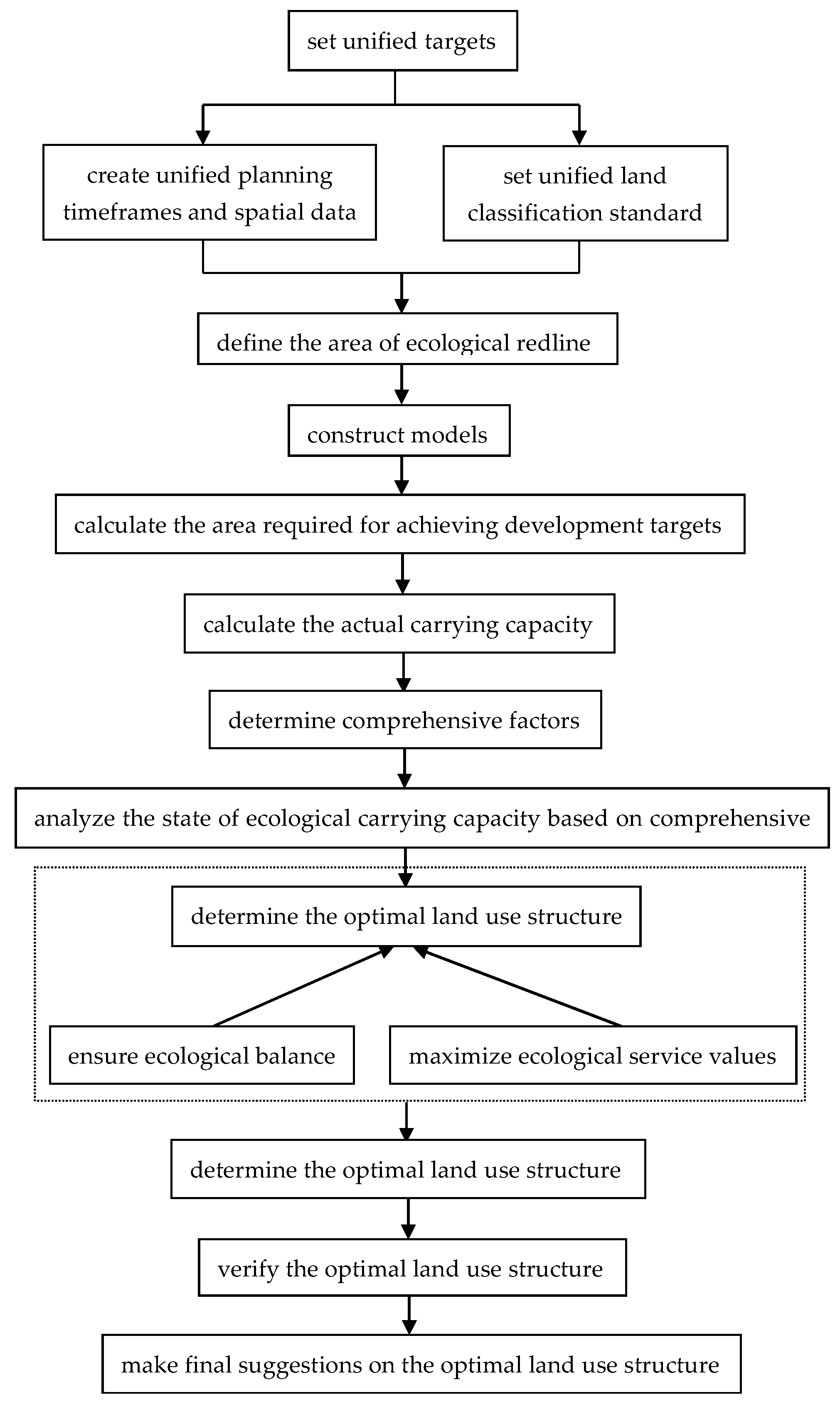
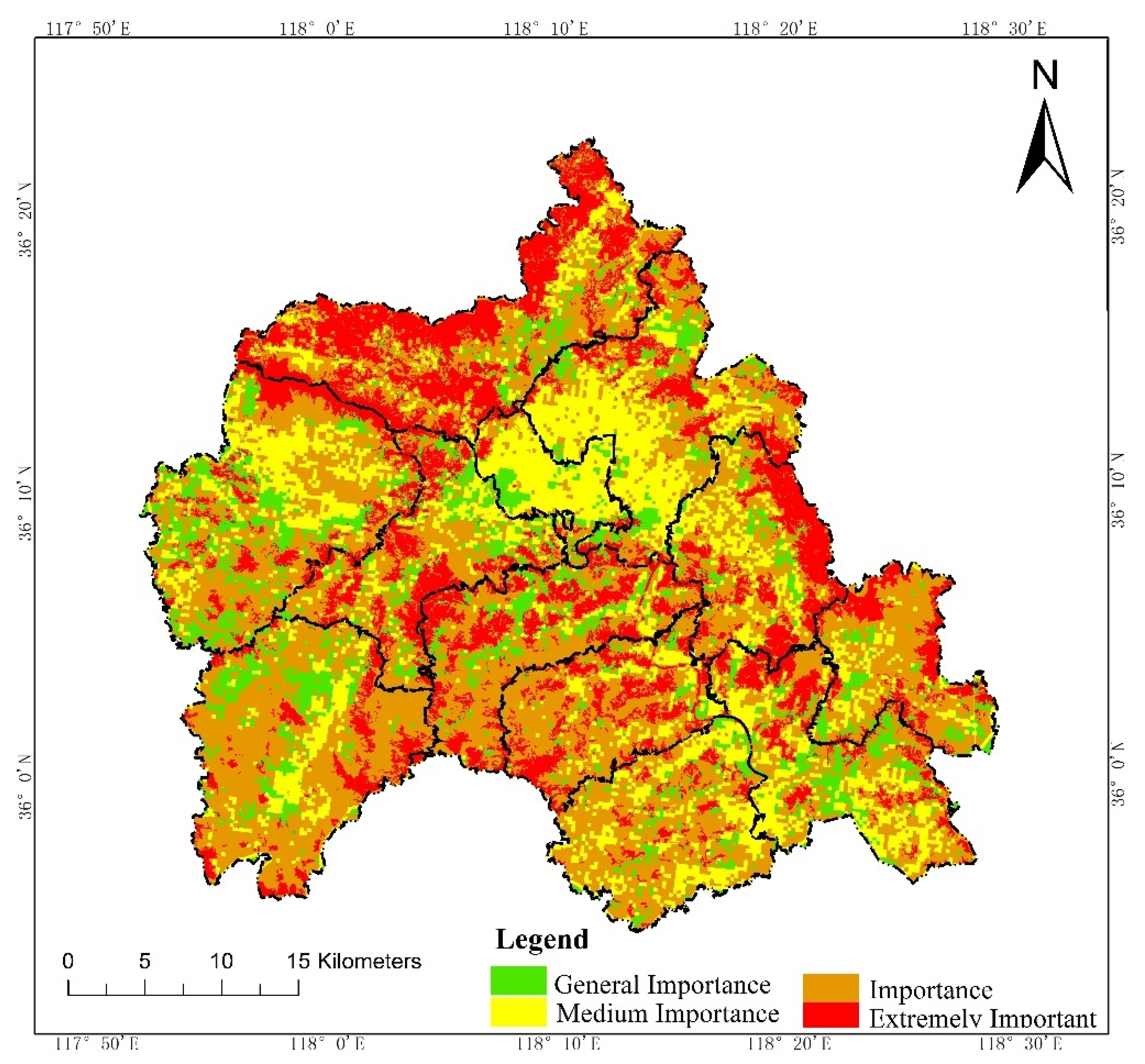
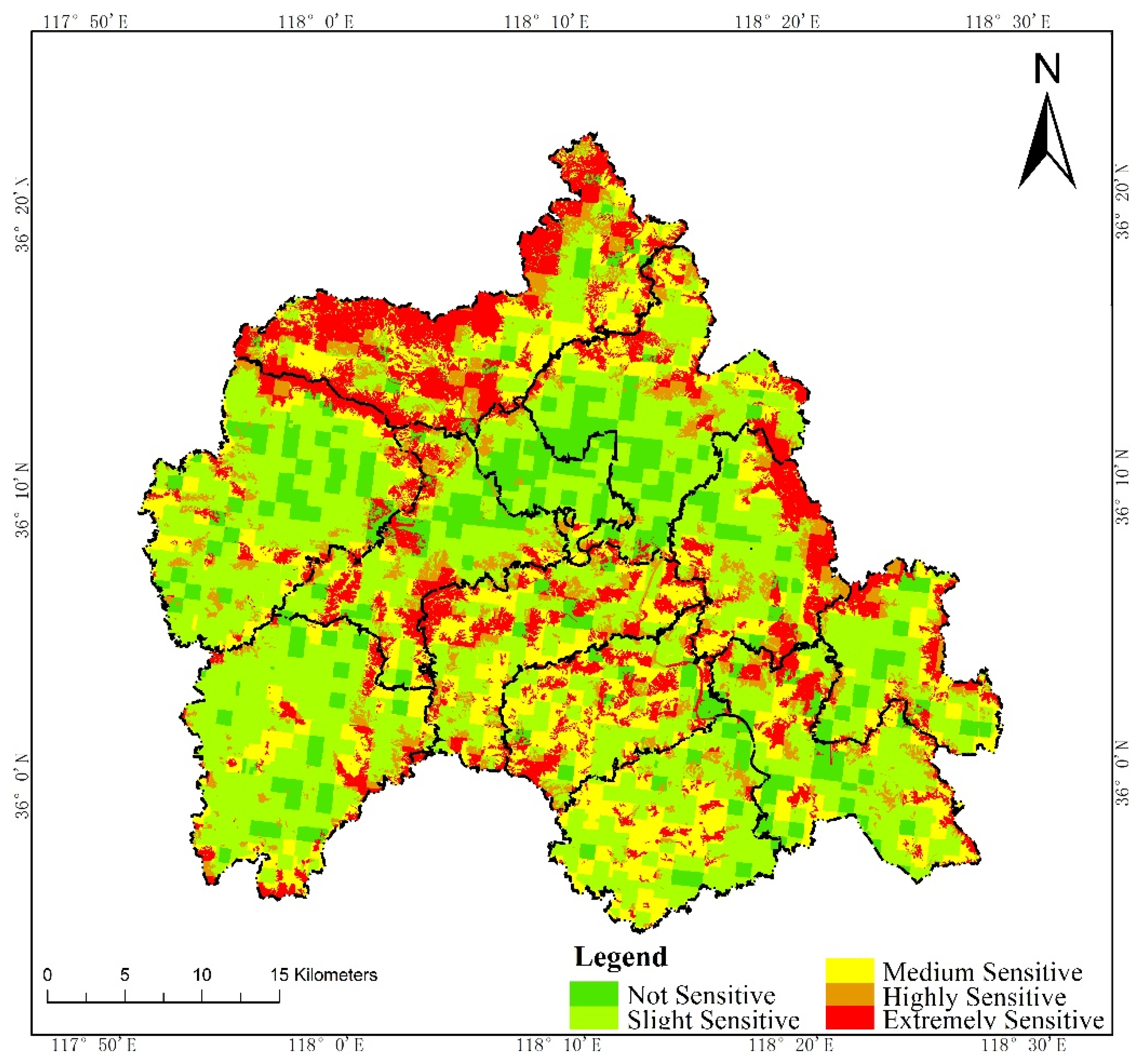

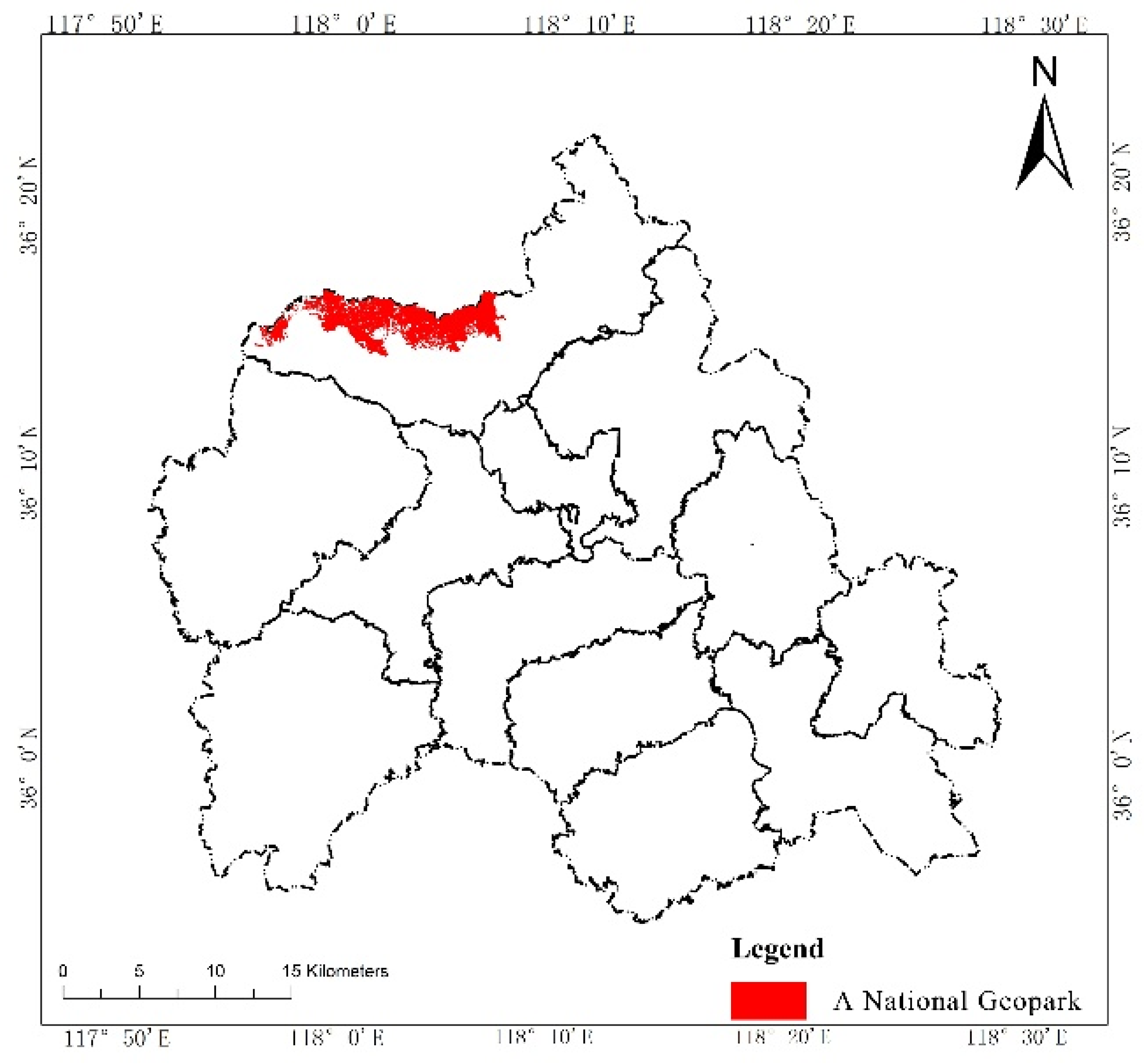

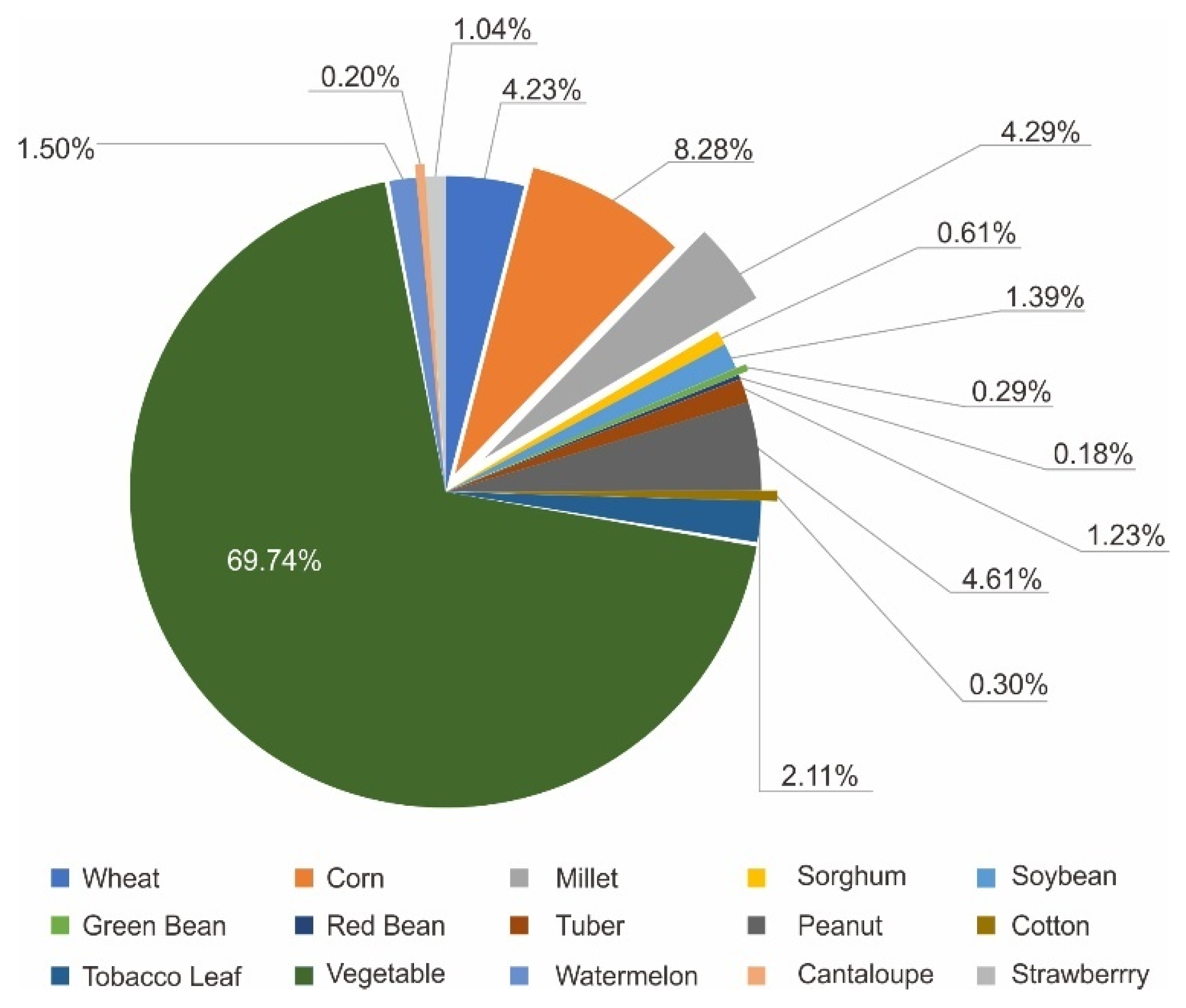
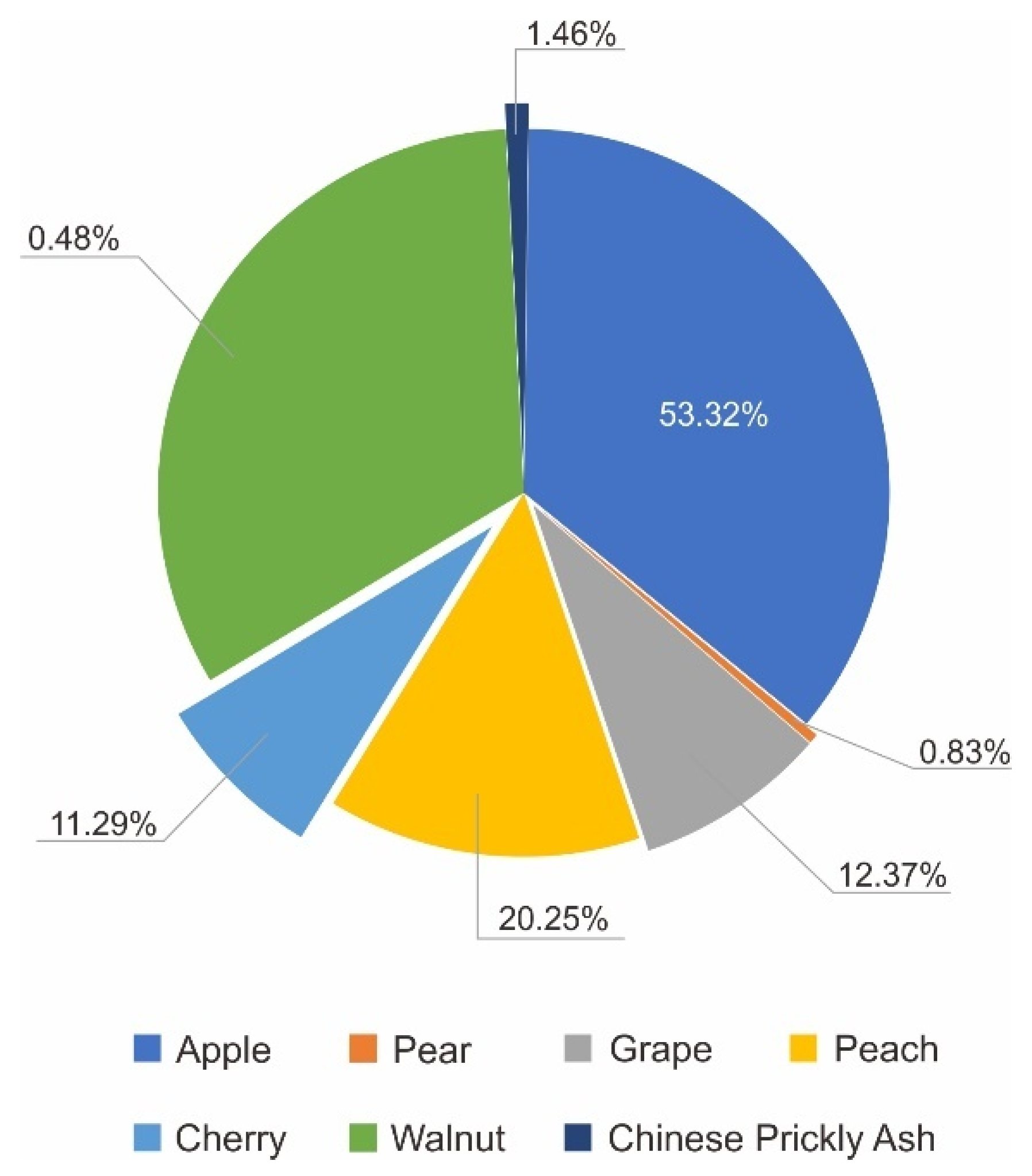

| Target | Function |
|---|---|
| Ecological Redline | Calculating area |
| Total Population | Calculating area |
| Urbanization Rate | Calculating area |
| GDP | Calculating area |
| Minimum Cultivated Land Area | Verifying area |
| Total Area of Construction Land | Verifying area |
| First-Level Classification | Second-Level Classification | Third-Level Classification | Fourth-Level Classification |
|---|---|---|---|
| Ecological Redline | — | — | — |
| Socio-economic Development Land | Agricultural Land | Cultivated Land | — |
| Garden Land | — | ||
| Forest Land | — | ||
| Grassland | — | ||
| Others | Ditch | ||
| Rural Road | |||
| Pit-pond | |||
| Agricultural Facility Land | |||
| Ridge | |||
| Construction Land | Urban and Rural Construction Land | Residential Land | |
| Public Management and Service Land | |||
| Commercial Service Land | |||
| Industrial Land | |||
| Urban and Rural Road Land | |||
| Transport Service Station Land | |||
| Salt Pan and Mining Land | |||
| Superfluous Land | |||
| Transportation Land and Water Conservancy Facilities Land | Railway Land | ||
| Rail Transit Land | |||
| Highway Land | |||
| Airport Land | |||
| Port Land | |||
| Pipeline Land | |||
| Water Conservancy Facilities Land | |||
| Other | Special Land | ||
| Water Area and Other Land | Water Area | Reservoir Surface | |
| River Surface | |||
| Lake Surface | |||
| Glaciers and Permanent Snow | |||
| Inland Beach | |||
| Coastal Beach | |||
| Marshland | |||
| Other Land | |||
| Formulas | Note | Number |
|---|---|---|
| animal husbandry product (kg/kg). | (1) | |
| garden land product (yuan/kg). | (2) | |
| forest land product (yuan/kg; timber, yuan/m3). | (3) | |
| represents the per-unit area yield of the grassland (kg/ha). | (4) | |
| represents the price of aquatic products (yuan/kg). | (5) | |
| represents the target output value of secondary and tertiary industry per unit area of construction land (yuan/ha). | (6) |
| Formulas | Note | Number |
|---|---|---|
| cultivated land product (kg/ha/a). | (7) | |
| represents the per-unit area yield of fruit (kg/ha/a). | (8) | |
| represents the area demand for forest land (ha); 1000 is used to represent the oxygen produced per-unit area of forest land that allows 1000 people to breathe (person/ha). | (9) | |
| animal husbandry product in rural consumption (kg/kg). | (10) | |
| represents the quantity of aquatic products consumed by the rural population (kg/person/a). | (11) | |
| represents the area of transportation land, water conservancy facilities land, and other construction land (ha). | (12) |
| Name | Year | Type | Source |
|---|---|---|---|
| Third National Land Survey Database | 2020 | Vector | Natural Resources Bureau |
| National Economic and Social Development Planning | 2021–2025 | Text | Development and Reform Bureau |
| Statistical Yearbook | 2016–2020 | Text | Statistical Bureau |
| Prices of Products in Primary Industry | 2015 | Text | Price Bureau |
| Unit Cost of Artificial Forest Production Activities | 2015 | Text | Forestry Bureau |
| Land Planning | 2021–2035 | Text, Vector | Natural Resources Bureau |
| Product | Land-Use Type | Area Demand (ha) |
|---|---|---|
| Corn (for agricultural development) | Cultivated Land | 6164.97 |
| Corn (for pig breeding) | Cultivated Land | 5086.94 |
| Corn (for poultry breeding) | Cultivated Land | 7234.78 |
| Corn (for egg production) | Cultivated Land | 2916.42 |
| Millet | Cultivated Land | 1695.19 |
| Sorghum | Cultivated Land | 331.17 |
| Soybean | Cultivated Land | 806.48 |
| Green Bean | Cultivated Land | 69.15 |
| Red Bean | Cultivated Land | 57.37 |
| Tuber | Cultivated Land | 1136.48 |
| Peanut | Cultivated Land | 1426.77 |
| Cotton | Cultivated Land | 128.90 |
| Tobacco Leaf | Cultivated Land | 279.75 |
| Vegetable | Cultivated Land | 3275.55 |
| Watermelon | Cultivated Land | 182.76 |
| Cantaloupe | Cultivated Land | 19.52 |
| Strawberry | Cultivated Land | 24.62 |
| Apple | Garden Land | 15,848.14 |
| Pear | Garden Land | 249.15 |
| Grape | Garden Land | 1743.52 |
| Peach | Garden Land | 5731.76 |
| Cherry | Garden Land | 1605.33 |
| Walnut | Garden Land | 80.69 |
| Chinese Prickly Ash | Garden Land | 125.03 |
| Forest Production Activities | Forest Land | 11,252.23 |
| Wood | Forest Land | 402.86 |
| Sheep | Grassland | 3898.75 |
| Fish | Water Area | 1574.23 |
| Land-Use Type | Area Demand (ha) |
|---|---|
| Cultivated Land (cultivated land products) | 24,902.85 |
| Cultivated Land (animal husbandry products) | 5617.58 |
| Garden Land | 1613.73 |
| Forest Land | 580.00 |
| Grassland | 455.11 |
| Water Area | 791.89 |
| Land-Use Type | Maximum Area (ha) | Minimum Area (ha) | Area Demand (ha) |
|---|---|---|---|
| Cultivated Land | 30,725.65 | 30,630.83 | 30,678.20 |
| Garden Land | 15,171.23 | 7093.79 | 10,374.08 |
| Forest Land | 6840.79 | 3049.26 | 4567.20 |
| Grassland | 2468.18 | 1322.43 | 1806.65 |
| Water Area | 1282.67 | 1039.09 | 1154.47 |
| Construction Land | 13,144.31 | 12,632.38 | 12,885.80 |
| Land-Use Type | Area (ha) | Land-Use Type | Area (ha) |
|---|---|---|---|
| Cultivated Land | 26,276.07 | Railway Land | 147.45 |
| Garden Land | 50,160.50 | Rail Transit Land | 0.00 |
| Forest Land | 43,997.56 | Highway Land | 1752.02 |
| Grassland | 19,302.78 | Airport Land | 0.00 |
| Ditches | 279.92 | Port Land | 0.00 |
| Rural Roads | 1277.64 | Pipeline Land | 0.00 |
| Pit-ponds | 201.91 | Water Conservancy Facilities Land | 91.25 |
| Agricultural Facility Land | 449.01 | Special Land | 209.57 |
| Ridge | 3853.88 | Reservoir Surface | 1484.86 |
| Residential Land | 7973.32 | River Surface | 2179.96 |
| Public Management and Service Land | 604.87 | Lake Surface | 0.00 |
| Commercial Service Land | 713.28 | Glaciers and Permanent Snow | 0.00 |
| Industrial Land | 1284.56 | Inland Beach | 7.41 |
| Urban and Rural Road Land | 419.95 | Coastal Beach | 0.00 |
| Transport Service Station Land | 49.12 | Marshland | 0.00 |
| Salt Pan and Mining Land | 549.33 | Other Land | 313.59 |
| Superfluous Land | 0.00 | Grand Total | 163,579.81 |
| Land-Use Type | Area Demand (ha) | Ecological Footprint (ha) |
|---|---|---|
| Cultivated land | 30,678.20 | 155,231.69 |
| Garden land | 10,374.08 | 47,513.29 |
| Forest land | 4567.20 | 33,386.23 |
| Grassland | 1806.65 | 3161.64 |
| Water area | 1154.47 | 31,932.64 |
| Construction land | 12,885.80 | 3994.60 |
| Grand total | 61,466.40 | 275,220.09 |
| Land-Use Type | Ecological Footprint (ha) | Carrying Capacity (ha) | Ecological Carrying Capacity (ha) | Ecological Surplus/ Ecological Deficit (ha) |
|---|---|---|---|---|
| Cultivated Land | 155,231.69 | 29,675.08 | 150,155.90 | −5075.79 |
| Garden Land | 47,513.29 | 43,916.71 | 201,138.53 | 153,625.24 |
| Forest Land | 33,386.23 | 18,794.03 | 137,384,.36 | 103,998.13 |
| Grassland | 3161.64 | 6519.59 | 11,409.28 | 8247.64 |
| Water Area | 31,932.64 | 3422.99 | 94,679.90 | 62,747.26 |
| Construction Land | 3994.60 | 14,133.92 | 4381.52 | 386.92 |
| Grand Total | 275,220.09 | 116,462.32 | 599,149.50 | 323,929.41 |
| Land-Use Type | Ecological Footprint (ha) | Carrying Capacity (ha) | Ecological Carrying Capacity (ha) | Ecological Surplus/ Ecological Deficit (ha) |
|---|---|---|---|---|
| Cultivated Land | 155,231.69 | 30,678.20 | 155,231.69 | 0.00 |
| Garden Land | 47,513.29 | 43,916.71 | 201,138.53 | 153,625.24 |
| Forest Land | 33,386.23 | 18,794.03 | 137,384.36 | 103,998.13 |
| Grassland | 3161.64 | 6519.59 | 11,409.28 | 8247.64 |
| Water Area | 31,932.64 | 3422.99 | 94,679.90 | 62,747.26 |
| Construction Land | 3994.60 | 13,130.80 | 4070.55 | 75.95 |
| Grand Total | 275,220.09 | 116,462.32 | 603,914.31 | 328,694.22 |
Publisher’s Note: MDPI stays neutral with regard to jurisdictional claims in published maps and institutional affiliations. |
© 2022 by the authors. Licensee MDPI, Basel, Switzerland. This article is an open access article distributed under the terms and conditions of the Creative Commons Attribution (CC BY) license (https://creativecommons.org/licenses/by/4.0/).
Share and Cite
Tang, L.; Yang, Y.; Wang, D.; Wei, Q. Optimizing County-Level Land-Use Structure Method: Case Study of W County, China. Int. J. Environ. Res. Public Health 2022, 19, 5281. https://doi.org/10.3390/ijerph19095281
Tang L, Yang Y, Wang D, Wei Q. Optimizing County-Level Land-Use Structure Method: Case Study of W County, China. International Journal of Environmental Research and Public Health. 2022; 19(9):5281. https://doi.org/10.3390/ijerph19095281
Chicago/Turabian StyleTang, Lijing, Yuanyuan Yang, Dongyan Wang, and Qing Wei. 2022. "Optimizing County-Level Land-Use Structure Method: Case Study of W County, China" International Journal of Environmental Research and Public Health 19, no. 9: 5281. https://doi.org/10.3390/ijerph19095281
APA StyleTang, L., Yang, Y., Wang, D., & Wei, Q. (2022). Optimizing County-Level Land-Use Structure Method: Case Study of W County, China. International Journal of Environmental Research and Public Health, 19(9), 5281. https://doi.org/10.3390/ijerph19095281







